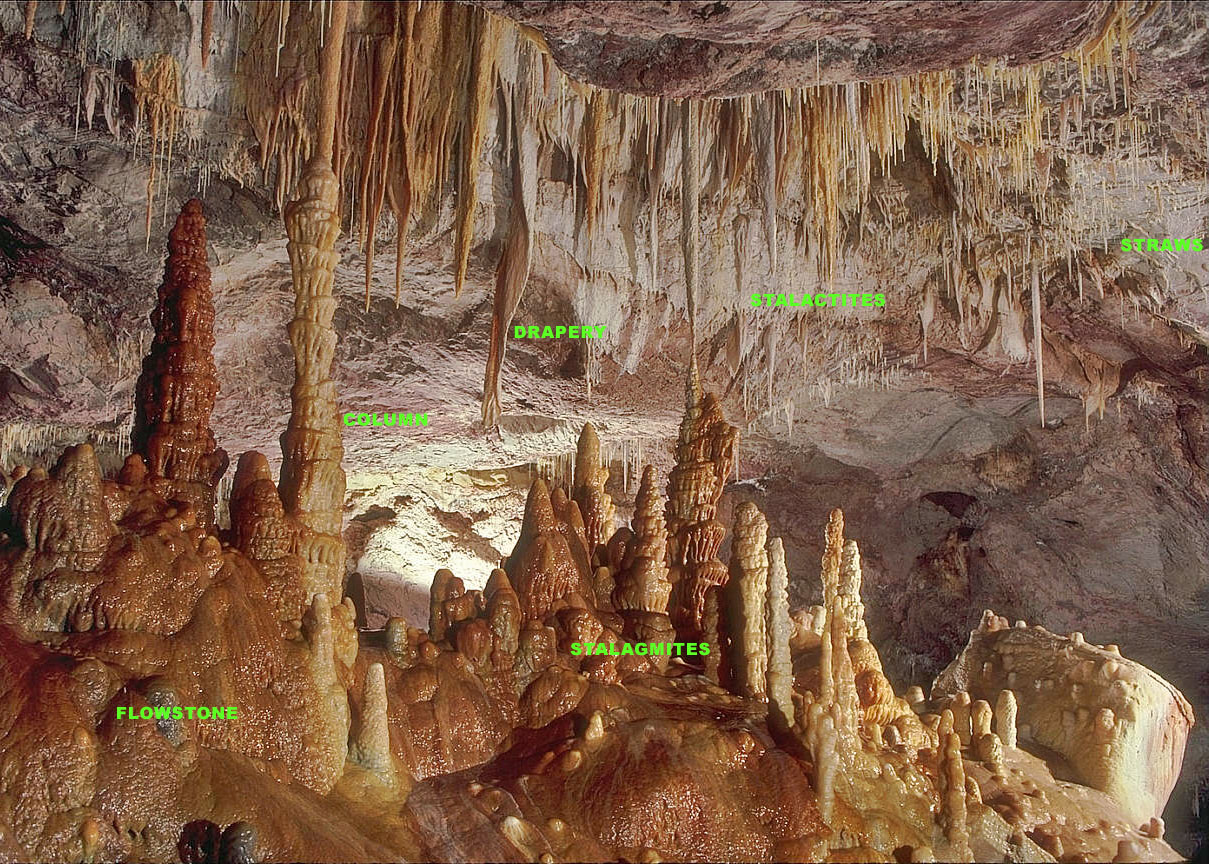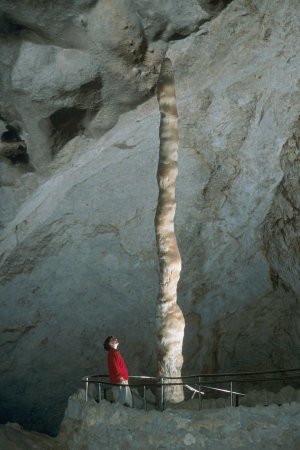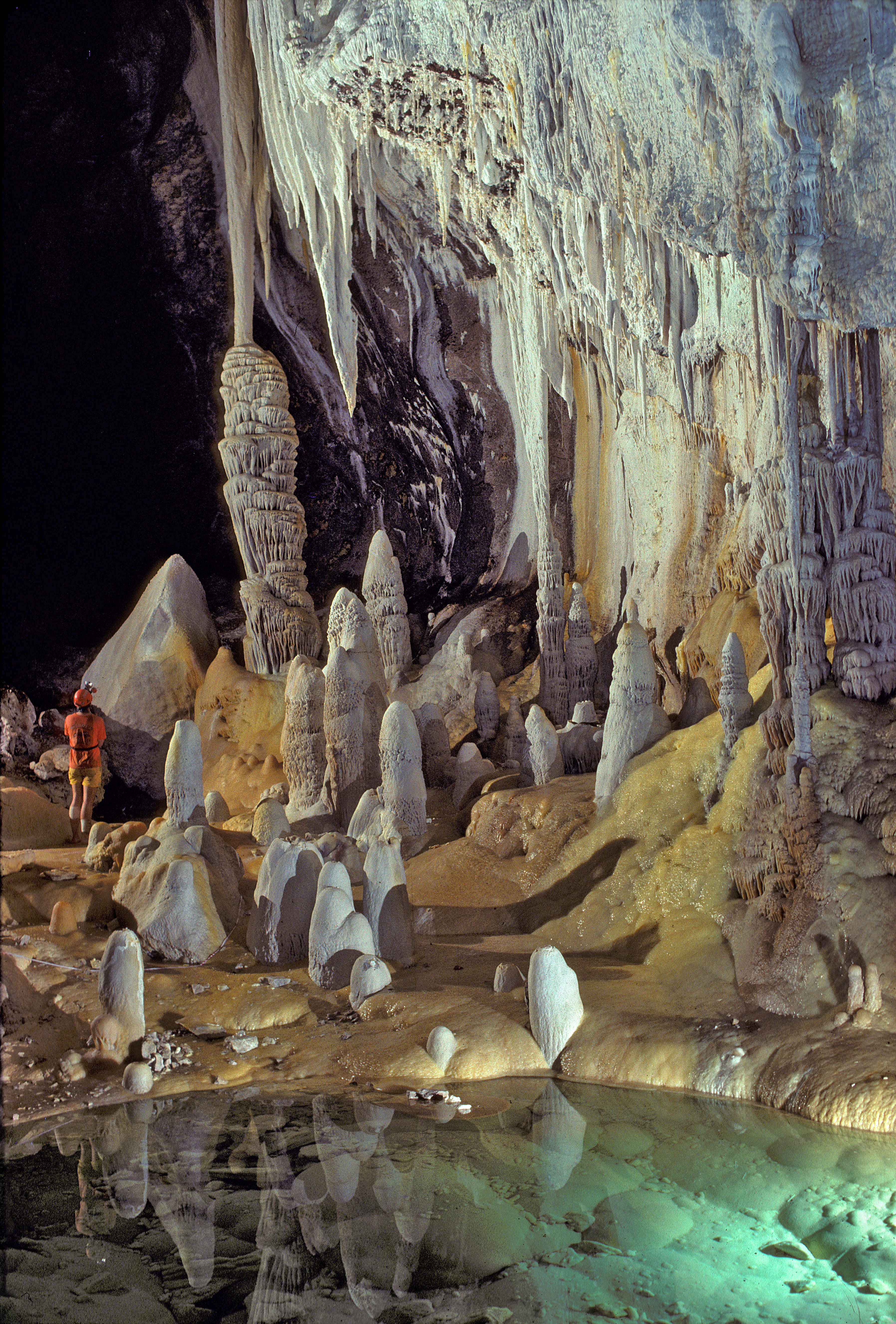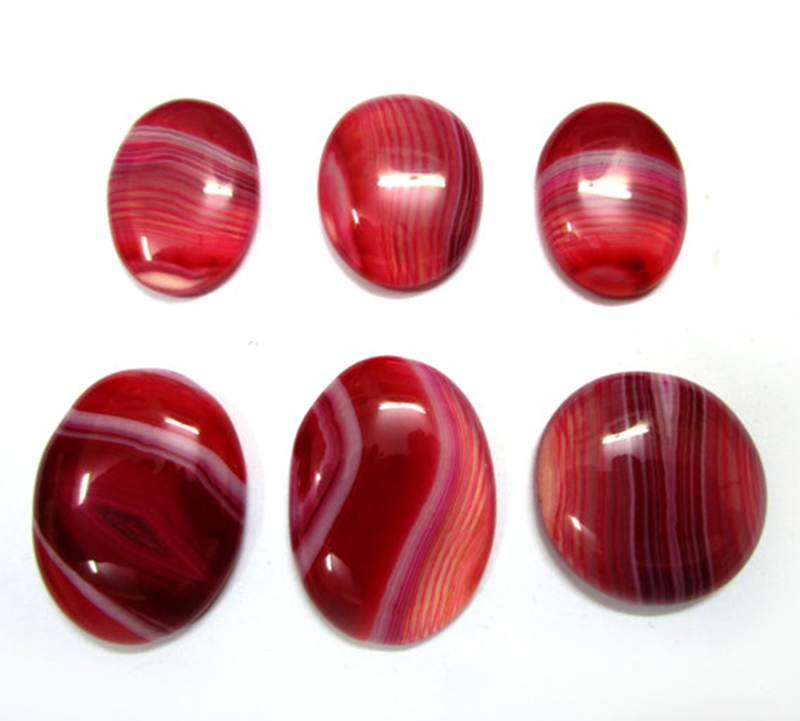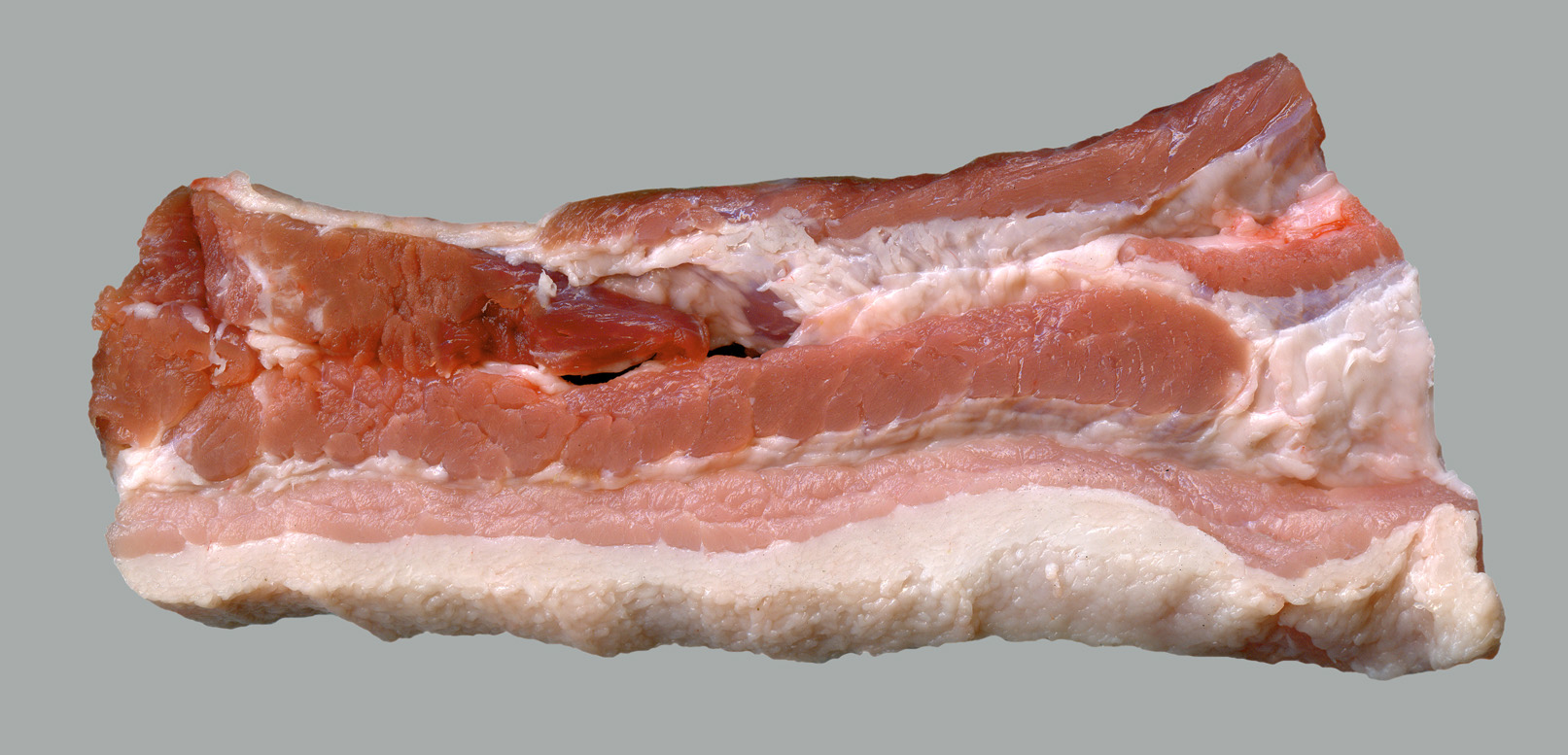|
Flowstone
Flowstones are sheetlike deposits of calcite or other carbonate minerals, formed where water flows down the walls or along the floors of a cave. They are typically found in "solution caves", in limestone, where they are the most common speleothem. However, they may form in any type of cave where water enters that has picked up dissolved minerals. Flowstones are formed via the degassing of vadose percolation waters. Flowstone may also form on manmade structures as a result of calcium hydroxide being leached from concrete, lime or mortar. These secondary deposits created outside the cave environment, which mimic the shapes and forms of speleothems, are classified as " calthemites" and are associated with concrete degradation.Smith, G.K., (2016). “Calcite Straw Stalactites Growing From Concrete Structures”, Cave and Karst Science, Vol.43, No.1, P.4-10, (April 2016), British Cave Research Association, ISSN 1356-191X. Formation Flowing films of water that move along floors or ... [...More Info...] [...Related Items...] OR: [Wikipedia] [Google] [Baidu] |
Calthemite
Calthemite is a secondary deposit, derived from concrete, lime, mortar or other calcareous material outside the cave environment.Smith, G.K. (2016). "Calcite straw stalactites growing from concrete structures", Cave and Karst Science 43(1), 4–10. http://bcra.org.uk/pub/candks/index.html?j=127Smith, G K., (2015). "Calcite Straw Stalactites Growing From Concrete Structures". Proceedings of the 30th 'Australian Speleological Federation' conference, Exmouth, Western Australia, edited by Moulds, T. pp 93 -108 Calthemites grow on or under, man-made structures and mimic the shapes and forms of cave speleothems, such as stalactites, stalagmites, flowstone etc.Hill, C A and Forti, P, (1997). Cave Minerals of the World, Second Edition. untsville, Alabama: National Speleological Society Inc. Calthemite is derived from the Latin ''calx'' (genitive ''calcis'') "lime" + Latin < Greek ''théma'', "deposit" meaning ‘something laid down’, (also Mediaeval Latin ''thema'', "deposit") and ... [...More Info...] [...Related Items...] OR: [Wikipedia] [Google] [Baidu] |
Concrete Degradation
Concrete degradation may have many different causes. Concrete is mostly damaged by the corrosion of reinforcement bars due to the carbonatation of hardened cement paste or chloride attack under wet conditions. Chemical damages are caused by the formation of expansive products produced by various chemical reactions, by aggressive chemical species present in groundwater and seawater (chlorides, sulfates, magnesium ions), or by microorganisms (bacteria, fungi...). Other damaging processes can also involve calcium leaching by water infiltration and different physical phenomena initiating cracks formation and propagation. All these detrimental processes and damaging agents adversely affects the concrete mechanical strength and its durability. The most destructive agent of concrete structures and components is probably water. Indeed, water often directly participates to chemical reactions as a reagent and is always necessary as a solvent, or a reacting medium, making transport of ... [...More Info...] [...Related Items...] OR: [Wikipedia] [Google] [Baidu] |
Speleothem
A speleothem (; ) is a geological formation by mineral deposits that accumulate over time in natural caves. Speleothems most commonly form in calcareous caves due to carbonate dissolution reactions. They can take a variety of forms, depending on their depositional history and environment. Their chemical composition, gradual growth, and preservation in caves make them useful paleoclimatic proxies. Chemical and physical characteristics More than 300 variations of cave mineral deposits have been identified. The vast majority of speleothems are calcareous, composed of calcium carbonate (CaCO3) minerals ( calcite or aragonite). Less commonly, speleothems are made of calcium sulfate (gypsum or mirabilite) or opal. Speleothems of pure calcium carbonate or calcium sulfate are translucent and colorless. The presence of iron oxide or copper provides a reddish brown color. The presence of manganese oxide can create darker colors such as black or dark brown. Speleothems can also be br ... [...More Info...] [...Related Items...] OR: [Wikipedia] [Google] [Baidu] |
Stalagmite
A stalagmite (, ; from the Greek , from , "dropping, trickling") is a type of rock formation that rises from the floor of a cave due to the accumulation of material deposited on the floor from ceiling drippings. Stalagmites are typically composed of calcium carbonate, but may consist of lava, mud, peat, pitch, sand, sinter, and amberat (crystallized urine of pack rats). The corresponding formation hanging down from the ceiling of a cave is a stalactite. Mnemonics have been developed for which word refers to which type of formation; one is that ''stalactite'' has a C for "ceiling", and ''stalagmite'' has a G for "ground", another is that, as with ants in the pants, the mites go up and the tights (tites) come down. Formation and type Limestone stalagmites The most common stalagmites are speleothems, which usually form in limestone caves. Stalagmite formation occurs only under certain pH conditions within the cavern. They form through deposition of calcium carb ... [...More Info...] [...Related Items...] OR: [Wikipedia] [Google] [Baidu] |
Stalactite
A stalactite (, ; from the Greek 'stalaktos' ('dripping') via ''stalassein'' ('to drip') is a mineral formation that hangs from the ceiling of caves, hot springs, or man-made structures such as bridges and mines. Any material that is soluble and that can be deposited as a colloid, or is in suspension, or is capable of being melted, may form a stalactite. Stalactites may be composed of lava, minerals, mud, peat, pitch, sand, sinter, and amberat (crystallized urine of pack rats). A stalactite is not necessarily a speleothem, though speleothems are the most common form of stalactite because of the abundance of limestone caves. The corresponding formation on the floor of the cave is known as a stalagmite. Mnemonics have been developed for which word refers to which type of formation; one is that ''stalactite'' has a C for "ceiling", and ''stalagmite'' has a G for "ground". Another example is that ''stalactites'' "hang on ''T''ight" and ''stalagmites'' "''M''ight grow up" � ... [...More Info...] [...Related Items...] OR: [Wikipedia] [Google] [Baidu] |
Cave
A cave or cavern is a natural void in the ground, specifically a space large enough for a human to enter. Caves often form by the weathering of rock and often extend deep underground. The word ''cave'' can refer to smaller openings such as sea caves, rock shelters, and grottos, that extend a relatively short distance into the rock and they are called ''exogene'' caves. Caves which extend further underground than the opening is wide are called ''endogene'' caves. Speleology is the science of exploration and study of all aspects of caves and the cave environment. Visiting or exploring caves for recreation may be called ''caving'', ''potholing'', or ''spelunking''. Formation types The formation and development of caves is known as '' speleogenesis''; it can occur over the course of millions of years. Caves can range widely in size, and are formed by various geological processes. These may involve a combination of chemical processes, erosion by water, tectonic forces, microorgan ... [...More Info...] [...Related Items...] OR: [Wikipedia] [Google] [Baidu] |
Onyx Cave (other)
Onyx Cave may refer to several things in the United States: * Onyx Cave (Arizona), a National Natural Landmark * Onyx Cave (Arkansas), a small show cave * Great Onyx Cave, Kentucky ** Great Onyx Cave Entrance, Mammoth Cave, Kentucky, listed on the NRHP in Kentucky * Crystal Onyx Cave, Kentucky *Onyx Cave (Newburg, Missouri), listed on the NRHP in Missouri *Onyx Mountain Caverns Onyx primarily refers to the parallel banded variety of chalcedony, a silicate mineral. Agate and onyx are both varieties of layered chalcedony that differ only in the form of the bands: agate has curved bands and onyx has parallel bands. Th ..., Missouri See also * Cave onyx {{Disambig ... [...More Info...] [...Related Items...] OR: [Wikipedia] [Google] [Baidu] |
Mystery Cave
Forestville Mystery Cave State Park is a state park in Minnesota. It contains the village of Forestville, which has been restored to a 19th-century appearance. The Minnesota Historical Society operates it as a historic site. Below ground the park contains Mystery Cave, the state's longest cave, which is open to the public. The park is between Spring Valley and Preston, Minnesota. Mystery Cave The park is in the Driftless Area, noted for its karst topography, which includes sinkholes and caves. The park is about from Mystery Cave and occupies approximately , with camping, interpretive programs, and hiking, horseback, cross-country skiing trails, cold water streams and excellent trout fishing. The cave includes stalactites, stalagmites, and underground pools, and is a constant . It has over of passages in two rock layers and is being resurveyed and remapped by volunteers. Geologic history About 450 million years ago sedimentary rocks were deposited as the land was intermitte ... [...More Info...] [...Related Items...] OR: [Wikipedia] [Google] [Baidu] |
Onyx
Onyx primarily refers to the parallel banded variety of chalcedony, a silicate mineral. Agate and onyx are both varieties of layered chalcedony that differ only in the form of the bands: agate has curved bands and onyx has parallel bands. The colors of its bands range from black to almost every color. Commonly, specimens of onyx contain bands of black and/or white. Onyx, as a descriptive term, has also been applied to parallel banded varieties of alabaster, marble, calcite, obsidian and opal, and misleadingly to materials with contorted banding, such as "Cave Onyx" and "Mexican Onyx". Etymology ''Onyx'' comes through Latin (of the same spelling), from the Ancient Greek , meaning "claw" or "fingernail". Onyx with flesh-colored and white bands can sometimes resemble a fingernail. The English word "nail" is cognate with the Greek word. Varieties Onyx is formed of bands of chalcedony in alternating colors. It is cryptocrystalline, consisting of fine intergrowths of the silica m ... [...More Info...] [...Related Items...] OR: [Wikipedia] [Google] [Baidu] |
Bacon
Bacon is a type of salt-cured pork made from various cuts, typically the belly or less fatty parts of the back. It is eaten as a side dish (particularly in breakfasts), used as a central ingredient (e.g., the bacon, lettuce, and tomato sandwich (BLT)), or as a flavouring or accent (as in bacon bits in a salad). Bacon is also used for barding and larding roasts, especially game, including venison and pheasant, and may also be used to insulate or flavour roast joints by being layered onto the meat. The word is derived from the Proto-Germanic ''*bakkon'', meaning "back meat". Meat from other animals, such as beef, lamb, chicken, goat, or turkey, may also be cut, cured, or otherwise prepared to resemble bacon, and may even be referred to as, for example, " turkey bacon". Such use is common in areas with significant Jewish and Muslim populations as both religions prohibit the consumption of pork. Vegetarian bacons such as "soy bacon" also exist. Curing and smoking ... [...More Info...] [...Related Items...] OR: [Wikipedia] [Google] [Baidu] |
Georgia (U
Georgia most commonly refers to: * Georgia (country), a country in the Caucasus region of Eurasia * Georgia (U.S. state), a state in the Southeast United States Georgia may also refer to: Places Historical states and entities * Related to the country in the Caucasus ** Kingdom of Georgia, a medieval kingdom ** Georgia within the Russian Empire ** Democratic Republic of Georgia, established following the Russian Revolution ** Georgian Soviet Socialist Republic, a constituent of the Soviet Union * Related to the US state ** Province of Georgia, one of the thirteen American colonies established by Great Britain in what became the United States ** Georgia in the American Civil War, the State of Georgia within the Confederate States of America. Other places * 359 Georgia, an asteroid * New Georgia, Solomon Islands * South Georgia and the South Sandwich Islands Canada * Georgia Street, in Vancouver, British Columbia, Canada * Strait of Georgia, British Columbia, Canada ... [...More Info...] [...Related Items...] OR: [Wikipedia] [Google] [Baidu] |
Alabama
(We dare defend our rights) , anthem = " Alabama" , image_map = Alabama in United States.svg , seat = Montgomery , LargestCity = Huntsville , LargestCounty = Baldwin County , LargestMetro = Greater Birmingham , area_total_km2 = 135,765 , area_total_sq_mi = 52,419 , area_land_km2 = 131,426 , area_land_sq_mi = 50,744 , area_water_km2 = 4,338 , area_water_sq_mi = 1,675 , area_water_percent = 3.2 , area_rank = 30th , length_km = 531 , length_mi = 330 , width_km = 305 , width_mi = 190 , Latitude = 30°11' N to 35° N , Longitude = 84°53' W to 88°28' W , elevation_m = 150 , elevation_ft = 500 , elevation_max_m = 735.5 , elevation_max_ft = 2,413 , elevation_max_point = Mount Cheaha , elevation_min_m = 0 , elevation_min_ft = 0 , elevation_min_point = Gulf of Mexico , OfficialLang = English , Languages = * English 95.1% * Spanish 3.1% , population_demonyms = Alabamian (We dare defend our rights) , anthem = "Alabama (state song), Alabama" , i ... [...More Info...] [...Related Items...] OR: [Wikipedia] [Google] [Baidu] |



